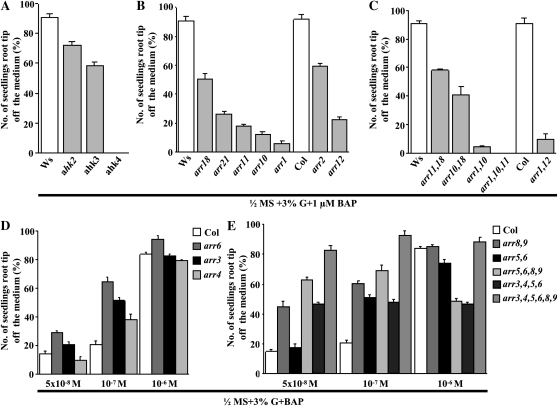Figure 4.
Comparison of the CK-induced root growth response of 7-d-old wild-type and CK signaling mutants. Wild-type and mutant seeds were sown on 3% G + BAP-containing half-strength MS medium and grown vertically in the light. The data presented are averages of three biological replicates, with each replicate having 30 seedlings and error bars representing sd. A, Comparison of the CK-induced root growth response of 7-d-old wild-type and CK receptor mutant seedling roots. The reduced CK-induced root growth response was found with ahk2 and ahk3, while no response was found in the ahk4 receptor mutant. B and C, Comparison of the CK-induced root growth response of 7-d-old wild-type and type B ARR signaling mutant seedling roots. The reduced CK-induced root growth response was found in many single and double mutants, while highly reduced CK-induced root growth was found in the arr1,10 double mutant and the arr1,10,11 triple mutant. D and E, Comparison of the CK-induced root growth response of 7-d-old Col and type A ARR signaling mutant seedling roots. Col and mutant seeds were directly sown on 3% G and different concentrations of BAP-containing half-strength MS medium and grown vertically in the light. Among the various lines tested, single mutants arr6 and arr3 and multiple mutants arr8,9, arr5,6,8,9, and arr3,4,5,6,8,9 display higher CK-induced root growth responses even at lower concentrations of BAP. Student’s t test, P < 0.05, n = 3 biological replicates.

